MARIANI’S
Virtual
Gourmet
September
13, 2015
NEWSLETTER

Bill
Murray in "Groundhog Day" (1993)
IN THIS ISSUE
DINING OUT IN LONDON, Part Three
By John Mariani
NEW YORK CORNER
GABRIEL KREUTHER
By John Mariani
NOTES FROM THE WINE CELLAR
CATCHING UP WITH GERMAN WINES
By Brian Freedman
❖❖❖
DINING OUT IN LONDON,
Part Three
By John Mariani
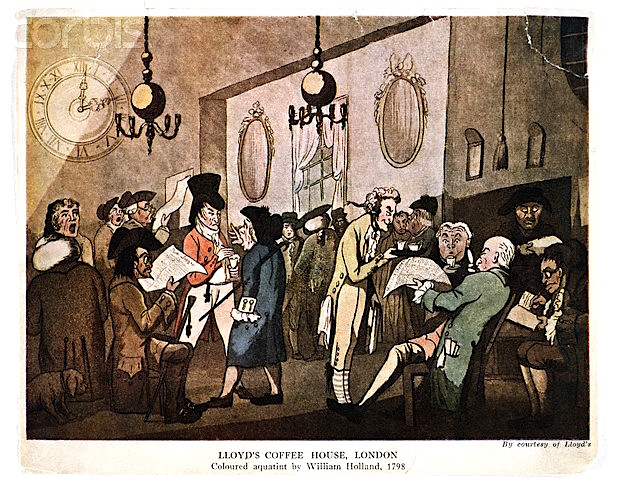
I
long ago accepted that I would never visit every
country in the world, but I’ve come to the point
where I take enormous pleasure in returning to my
favorite hotels and dining at restaurants that stay
in my memory as among the happiest moments of my
maverick life as a writer. Here are two I find hard to
resist whenever I go to London.
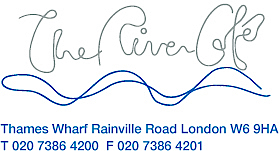
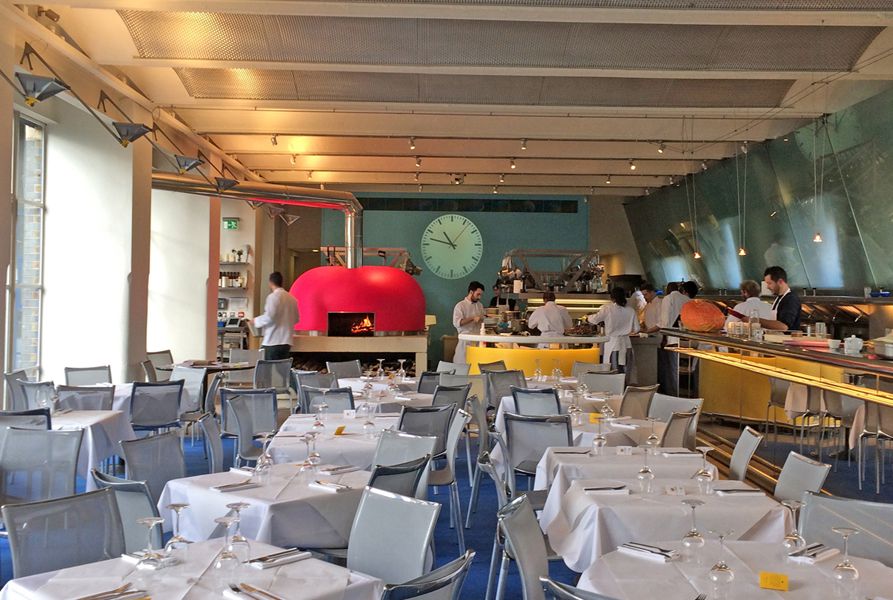
Few
restaurants anywhere can claim the success of
The River Café, which, since opening in 1987 in Hammersmith on the
Thames, a good 30 minutes from the center of
London, has rarely had an empty seat at lunch or
dinner, seven days a week. What’s
more, everyone seems to know one another, guests
and staff.
When people carp that it’s like an
exclusive club, that’s only because its regulars
are legion.
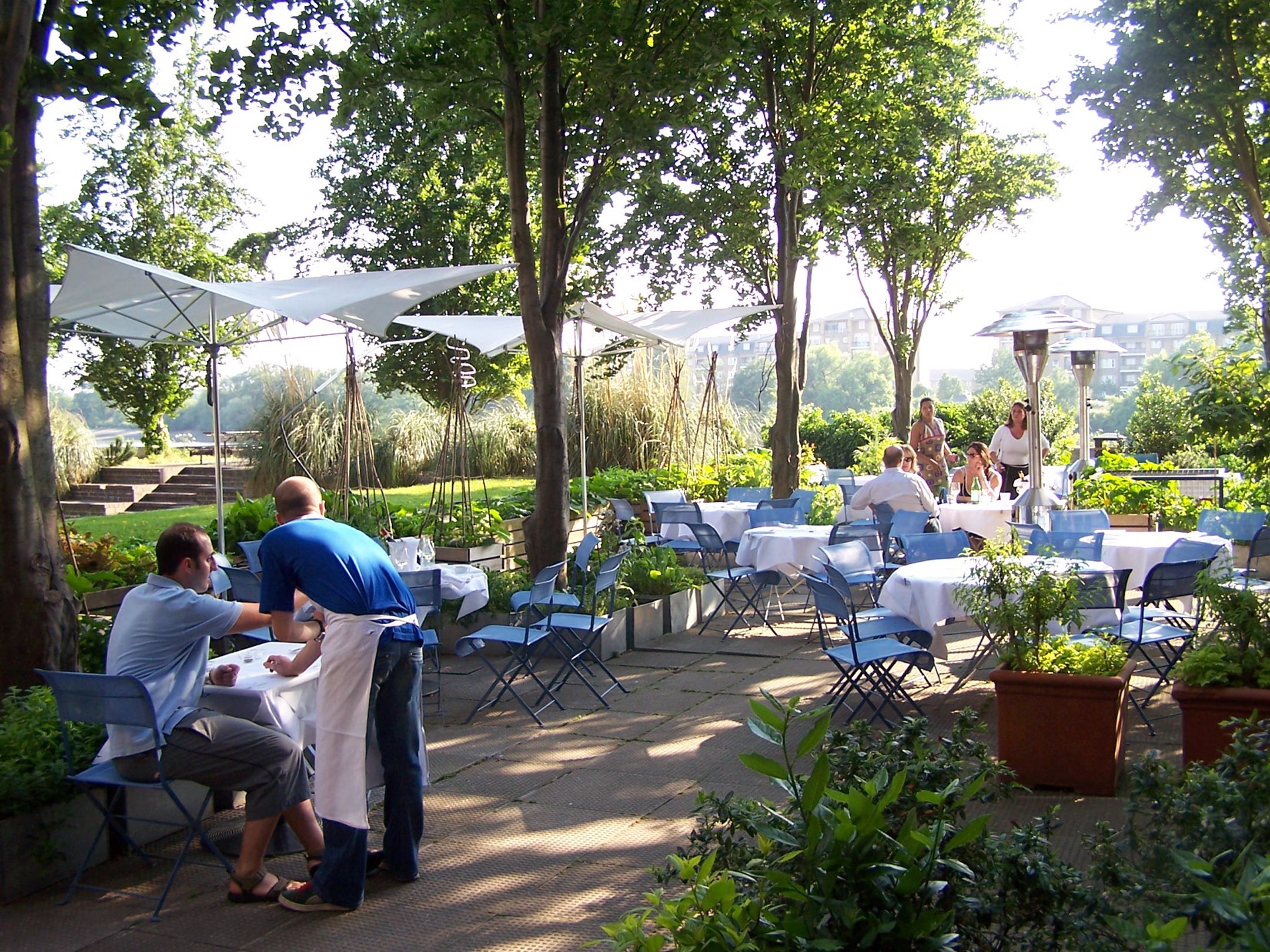 Opened by
Ruth Rogers and the late Rose Gray (both untaught
cooks, now with six best-selling cookbooks to their
credit) as a kind of canteen for the staff in the
design building it occupies, The River Café was
immediately recognized as something completely
different and new in London--a restaurant that
diverged from the Italian restaurants of the time
(which were really more Italian-American in style)
to be more traditional and regional, alla cucina
rustica with a Ligurian slant that prized
simplicity and flavor first and last.
Opened by
Ruth Rogers and the late Rose Gray (both untaught
cooks, now with six best-selling cookbooks to their
credit) as a kind of canteen for the staff in the
design building it occupies, The River Café was
immediately recognized as something completely
different and new in London--a restaurant that
diverged from the Italian restaurants of the time
(which were really more Italian-American in style)
to be more traditional and regional, alla cucina
rustica with a Ligurian slant that prized
simplicity and flavor first and last.
Despite a
fire not too long ago, the
place retains the same breezy, open, pastel colors
and light it’s always had, with a wide open kitchen
and a window wall overlooking a backyard lawn that
is very popular in good weather, which is always
iffy in London.
Rogers, who is still very much on
the kitchen line, and Executive Chefs Sian Wyn Owen
and Joseph Trivelli work small wonders with very few
ingredients, exemplified on my last visit by a dish
of summer peas and cuttlefish (£20) so deftly mixed
as to be at a level of flavor and texture no other
cuttlefish dish (below)
I’ve ever had has achieved. Carne cruda
of veal--a classic Piemontese dish--was finely
chopped raw rump meat with squashed tomato on
bruschetta and aged pecorino (£20).
Oddly enough, pasta dishes here
are few in number--the pasta itself is made in daily
batches only enough for lunch and dinner--but every
one maintains the Rogers-Gray mantra that the food
taste like what they’d enjoyed in homes in Italy
according to the seasons, typified by ravioli
stuffed with buffalo ricotta, garden herbs and lemon
zest with marjoram butter and pecorino (£19) and the
strozzapretti
with basil 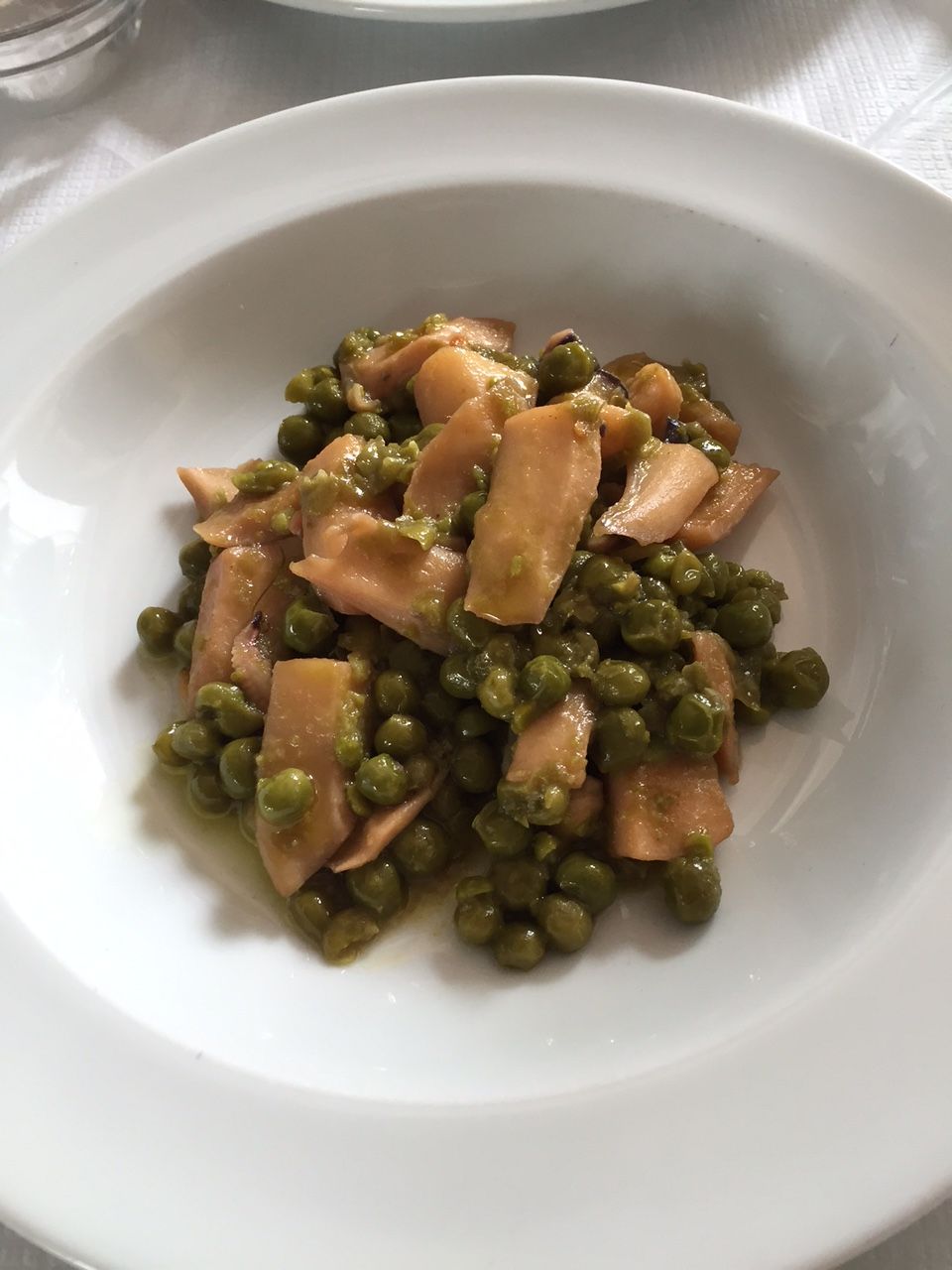 pesto and
green beans alla
genovese (£19). One of the signature dishes
here is the linguine with crab (£20), dressed with
olive oil and a shot of chopped chile peppers.
pesto and
green beans alla
genovese (£19). One of the signature dishes
here is the linguine with crab (£20), dressed with
olive oil and a shot of chopped chile peppers.
Seafood
is
always dependable here, especially wood-roasted
turbot (below),
this summer with anchovy, capers and flowering
oregano with summer beets and garden rocket (£42). If it’s
on the menu I always order the squab, wood-roasted
to a rosy turn with Tuscan red wine and roast
potatoes. The
enormous char-grilled beef sirloin with borlotti
beans, mustard, Sorrento tomatoes, and basil (£40)
can usually be seen on a sizable number of tables
each day, and it’s more than enough to share.
For dessert the excellent gelati are
recommended (two for £8) or the dense and decadent
Chocolate Nemesis (£10), which they dare not take
off the menu.
There is also a selection of fine cheeses
(three for £13, five for £23).
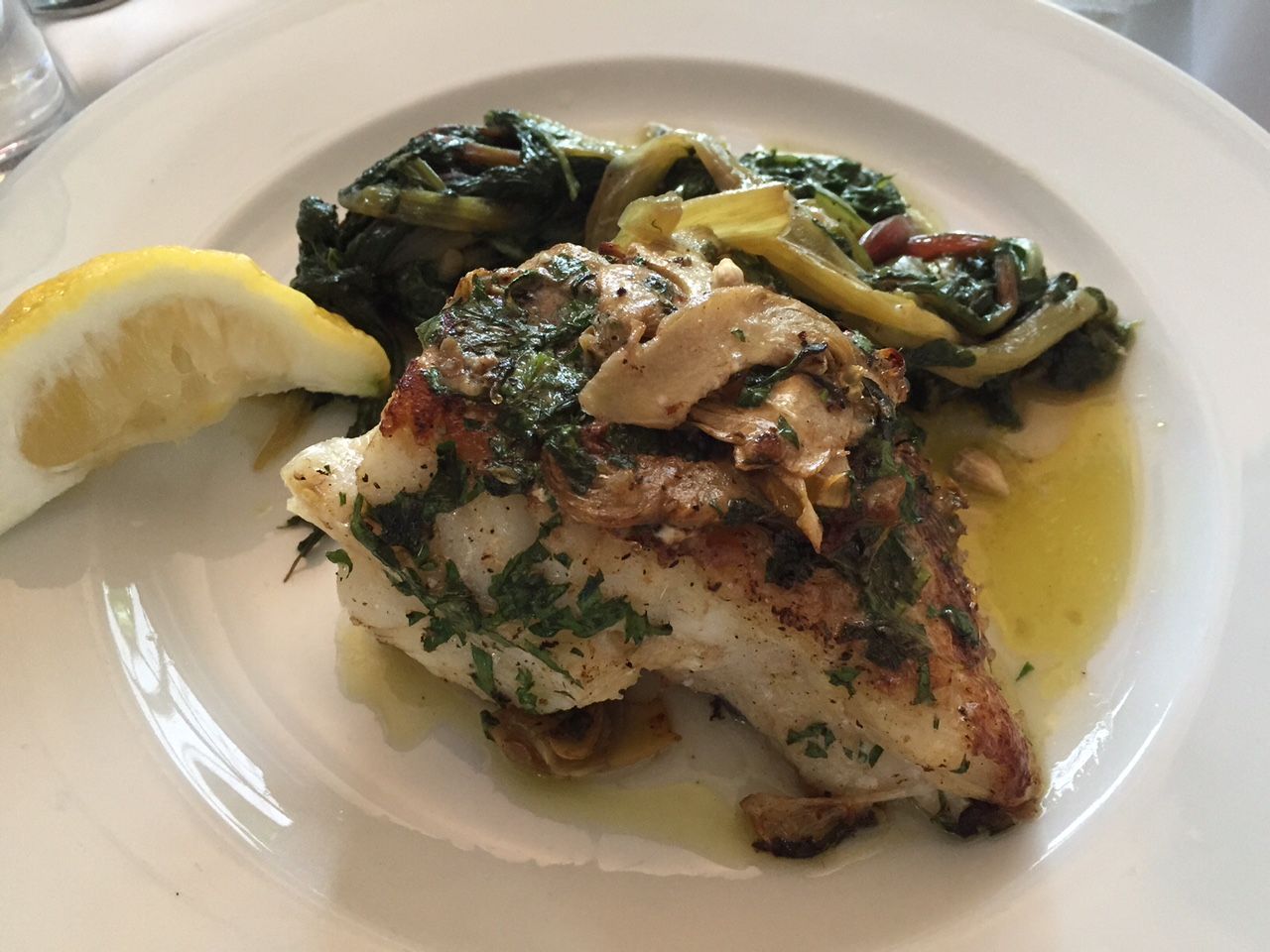 The River
Café’s wine list has always been resolutely Italian,
largely culled from small producers in every region
of the country, and mark-ups are not too bad.
The River
Café’s wine list has always been resolutely Italian,
largely culled from small producers in every region
of the country, and mark-ups are not too bad.
First-time visitors to the
restaurant may balk at the prices--this is only
Italian food!--but you really cannot serve
first-quality crab in a pasta dish for less than
£20, and that massive £40 sirloin of beef is as good
as any in London. (The sirloin, without any
vegetables, at Smith & Wollensky is £52.)
Just as important is
the notion that you are dining not only in one of
London’s best restaurants but one of its most
pioneering and innovative, consistently delivering a
kind of food others have been copying for two
decades now. And
on a summer’s day on the gently flowing Thames,
there are few places many people would rather be.
The River Café is open for lunch and
dinner daily.
DINNER BY HESTON BLUMENTHAL
Mandarin Oriental Hotel
66 Knightsbridge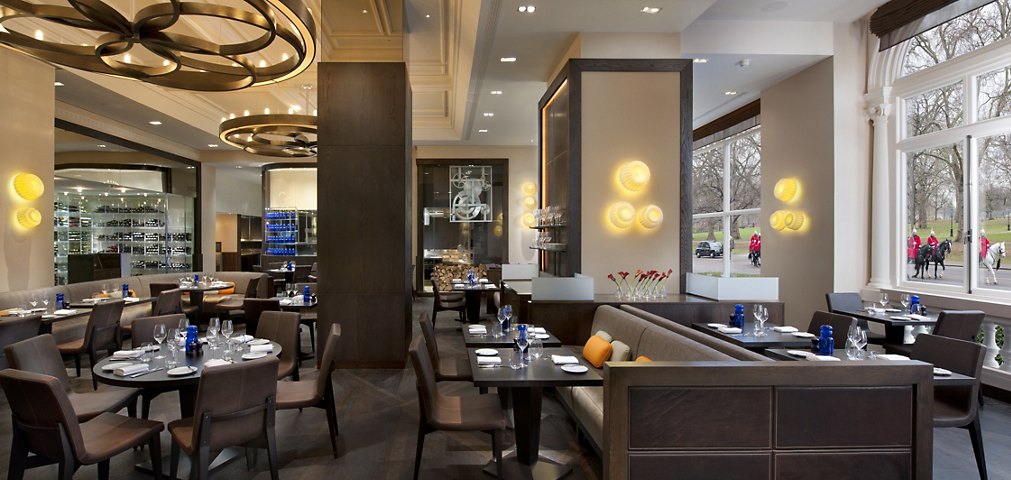
+44 (0)20 7235 2000
mandarinoriental.com/london/fine-dining/dinner-by-heston-blumenthal
Having dined here two years
ago with a friend, I couldn’t wait to come back
again, this time with my wife, whose palate brooks
no imperfections in a dish, no matter how
illustrious the name of the chef. In this
case the name is very illustrious indeed: Heston
Blumenthal, who has, for more than a decade, held
three Michelin stars for his wildly modernist
restaurant the Fat Duck in Bray (also home to the
very traditional three-star Waterside Inn).
Blumenthal’s entry into the
center of London, at the Mandarin Oriental Hotel,
caused a flurry of speculation at what kind of mad
molecular experiments he would undertake for a
larger clientele.
Instead, Blumenthal went head over heels
retro, bringing back dishes London hasn’t seen for
centuries; still, he landed back on his feet in an
effort to show how very antiquated dishes could be
brought winningly into the 21st century, and they
manifest his showmanship, not just show-off tricks.
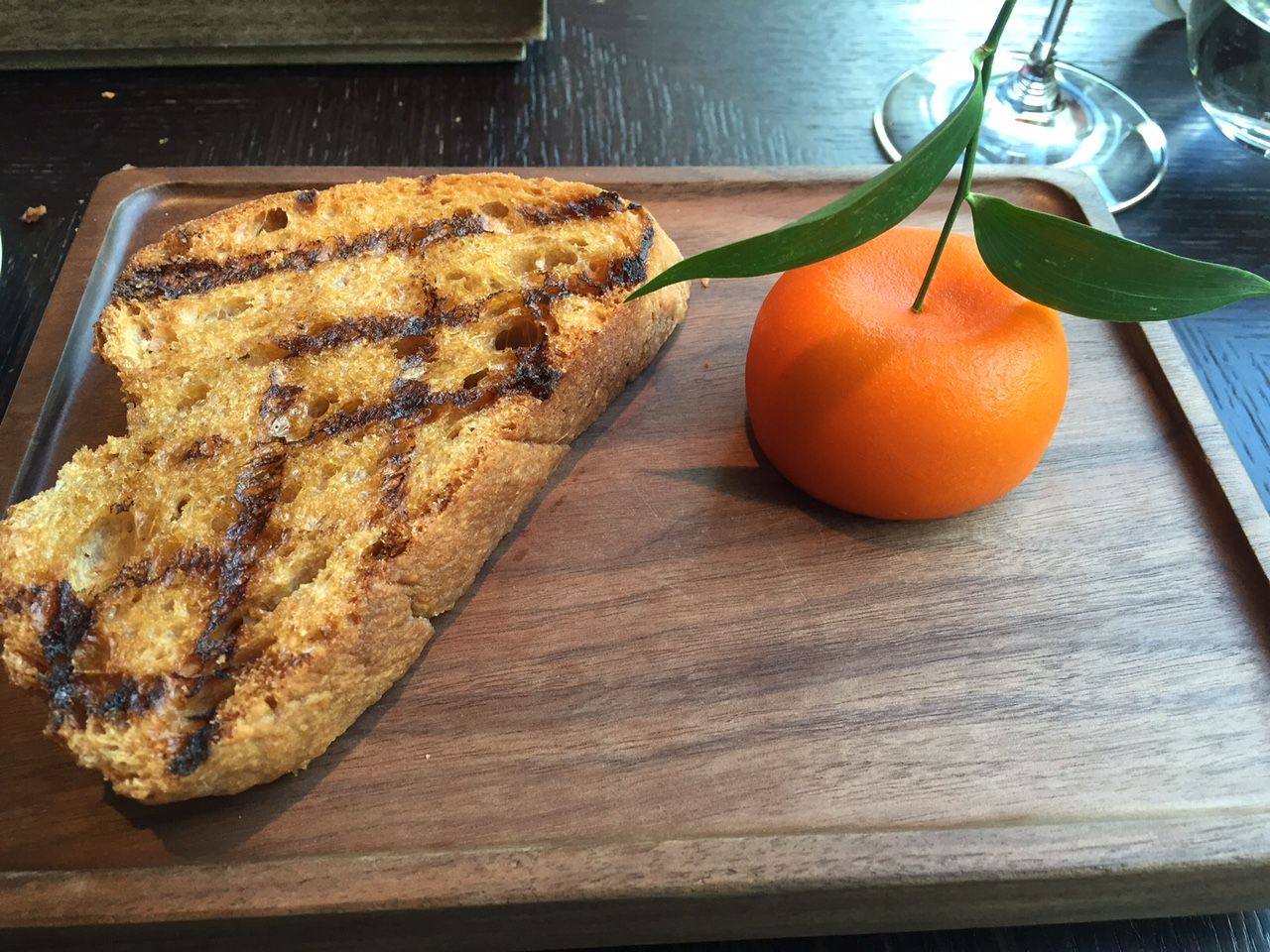 There’s a very reasonable
three-course lunch menu at £38, as well as à la
carte; a six-person “Chef’s Table” is situated directly opposite the show
kitchen where Executive Chef Ashley Palmer-Watts
(with Blumenthal since 1999) serves eight tasting
courses in season, at £150 per person for lunch
and £200 for dinner (with a minimum of four guests
required). VAT
tax and service are included.
There’s a very reasonable
three-course lunch menu at £38, as well as à la
carte; a six-person “Chef’s Table” is situated directly opposite the show
kitchen where Executive Chef Ashley Palmer-Watts
(with Blumenthal since 1999) serves eight tasting
courses in season, at £150 per person for lunch
and £200 for dinner (with a minimum of four guests
required). VAT
tax and service are included.
The oddly configured dining room
provides a floor-to-ceiling view of the leafy
outside, and you won’t find a better service staff
in the city to attend to any request. The open
kitchen was designed as in a royal house, with a
pulley roasting system, and porcelain wall sconces in
the shape of antique jelly molds.
The
menu names, some dating to as early as 1390, don’t
tell you much: “Meat fruit,” “Salamagundy,” “Rice
& Flesh,” and underneath each is a mere mention
of ingredients.
But once this food has been seen and tasted,
you understand something of the fun that invests the
old nursery rhyme’s “four and twenty blackbirds
baked in a pie.”
No black birds on Dinner’s menu as yet, but
you will find that lovely Meat Fruit (£17.50) crafted by putting
chicken liver parfait inside what looks like a
perfect orange, served with grilled bread (left).
Salamagundy
(circa 1720) derives from a French word for
hodgepodge; here it comes as chicken oysters,
salsify, bone marrow and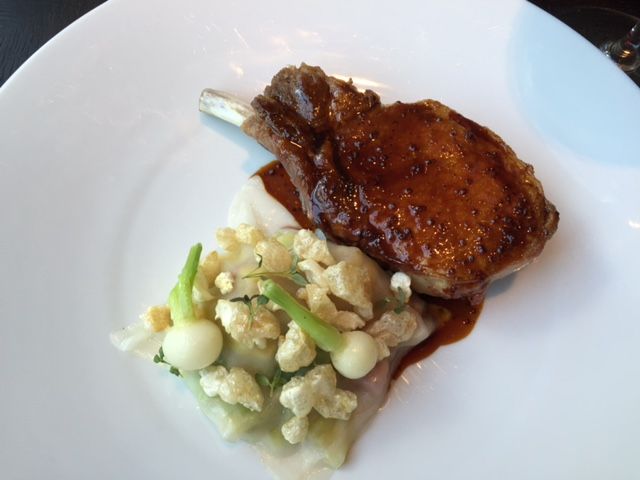 assertive horseradish
cream (£17.50), while Spiced Pigeon
is cooked in ale and served simply with
artichokes.
Iberian pork chop (circa 1820) is the star
of a dish of great succulence (right), with
“pointy cabbage,” onions and a classic sauce
Robert of a demi-glace laced with brown mustard (£36).
assertive horseradish
cream (£17.50), while Spiced Pigeon
is cooked in ale and served simply with
artichokes.
Iberian pork chop (circa 1820) is the star
of a dish of great succulence (right), with
“pointy cabbage,” onions and a classic sauce
Robert of a demi-glace laced with brown mustard (£36).
Desserts
can be as deceptively simple as brown bread ice
cream (circa 1830) with salted caramel and a
pear-and-malted yeast syrup (£12) or a tipsy cake (circa
1810) of sweet brioche soaked with spit-roasted
pineapple, Sauternes, brandy and vanilla (£14). They
also make ice cream right before your eyes, if you
wish.
The
wine list is expertly put together, and your cordial
sommelier will be helpful in every category and
budget.
If you
turn over the menu, you’ll find the source of
Blumenthal’s historic dishes, such as the 1670
recipe book titled The Queen Like
Closet or Rich Cabinet by Hannah Wooley. It is
nearly impossible to know precisely what such
ancient dishes tasted like at the time, but in
Blumenthal’s hands they become as modern--though not
modernistic--as any in Britain today.
Dinner by Heston Blumenthal is open
for lunch and dinner daily.
❖❖❖
By John Mariani
GABRIEL KREUTHER
41 West 42nd Street (near Avenue of the
Americas)
212-257-5826
www.gknyc.com
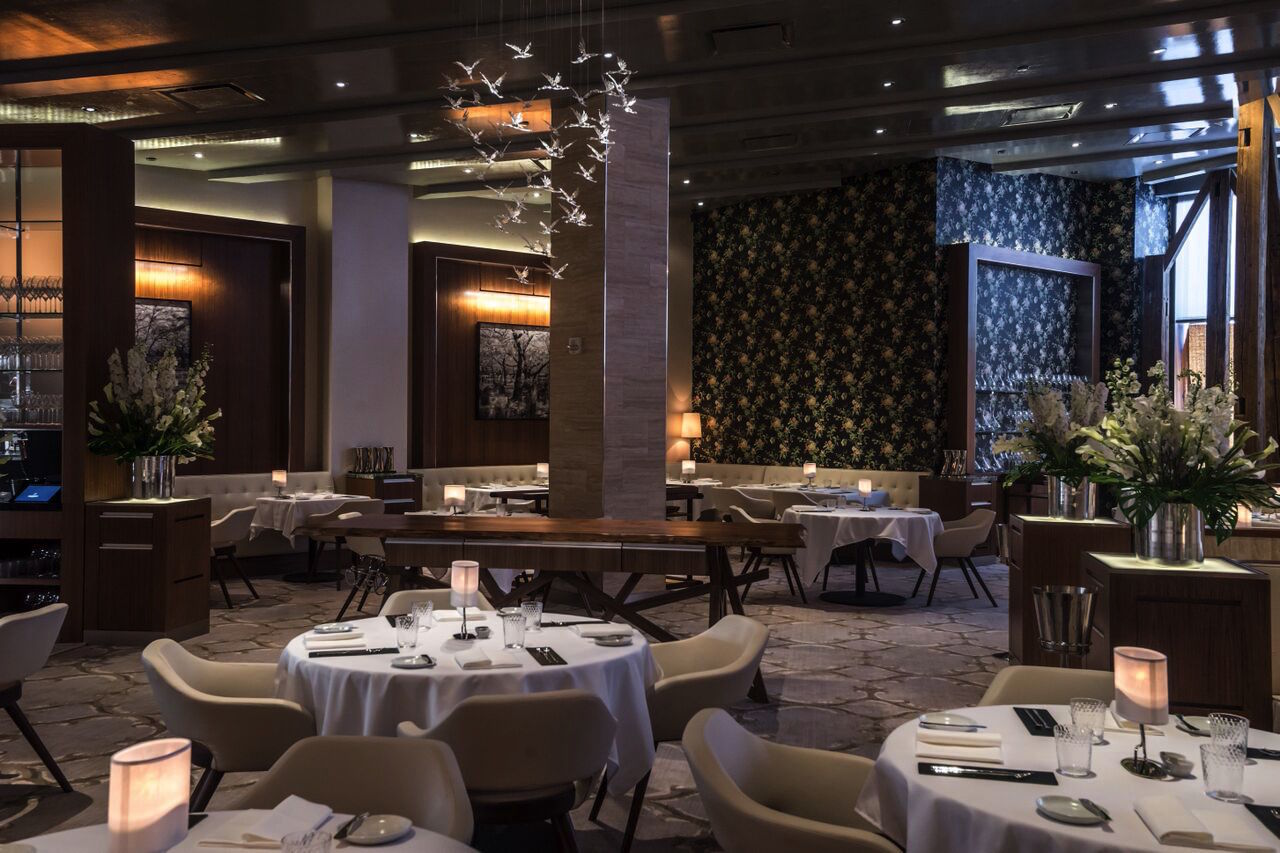 As I surveyed the large,
bustling dining room at the beautiful new
restaurant Gabriel Kreuther across from Bryant
Park, I was yet again reminded that fine
dining at the highest level has never been
more vibrant in Manhattan. Just as the
tables are full tonight at Le Bernardin,
Aureole, Daniel, Jean-Georges, The Modern, La
Grenouille, Per Se, Le Cirque, Picholine,
Lincoln Ristorante, Marea, Eleven
Madison Park, and The Four Seasons, so, too,
are the 100 seats at this stunning new
restaurant named for Chef Gabriel Kreuther,
congenially occupied six nights a week by
well-dressed people who expect a civilized
evening to unfold without blasting music, bare
tables, and t-shirted waiters who never seem
to know who gets what.
As I surveyed the large,
bustling dining room at the beautiful new
restaurant Gabriel Kreuther across from Bryant
Park, I was yet again reminded that fine
dining at the highest level has never been
more vibrant in Manhattan. Just as the
tables are full tonight at Le Bernardin,
Aureole, Daniel, Jean-Georges, The Modern, La
Grenouille, Per Se, Le Cirque, Picholine,
Lincoln Ristorante, Marea, Eleven
Madison Park, and The Four Seasons, so, too,
are the 100 seats at this stunning new
restaurant named for Chef Gabriel Kreuther,
congenially occupied six nights a week by
well-dressed people who expect a civilized
evening to unfold without blasting music, bare
tables, and t-shirted waiters who never seem
to know who gets what.
True, finding a location,
designing the space, hiring the best staff, and
stocking a great wine list make the idea of
opening such a restaurant in a city of rents
beyond exorbitant quite an iffy proposition. But the
owners and investors are willing to bet on
Kreuther’s reputation, a buoyant midtown economy,
and a clientele in search of the very best.
Kreuther earned his ranking
among NYC’s great French masters while at The
Modern for ten years, and his return to the stoves
has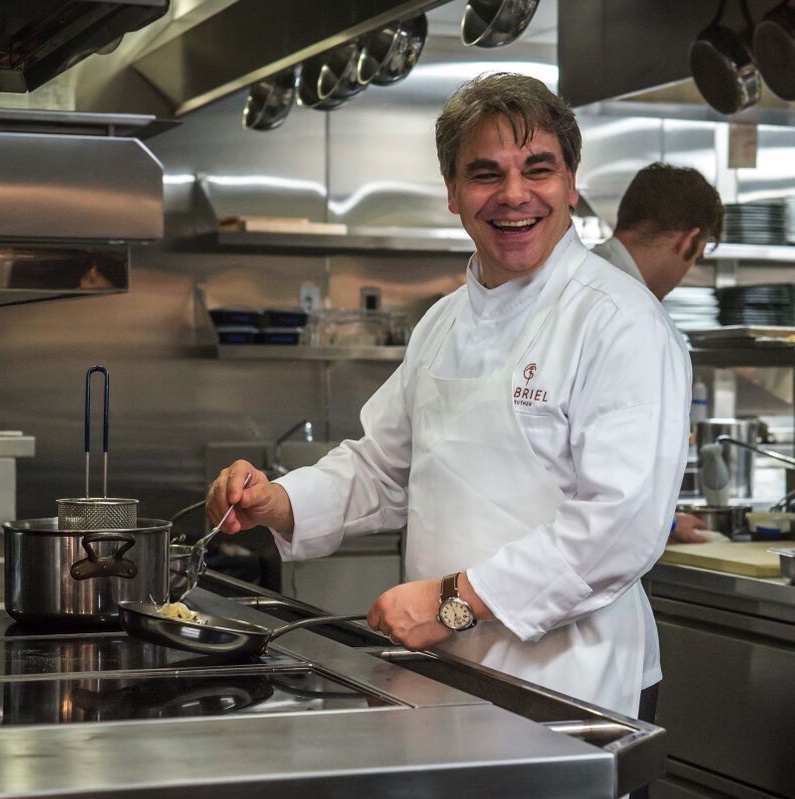 been eagerly awaited by his fans
and the food media.
So the opening of his restaurant (I’ll call
it “GK”) is easily the big restaurant news item of
2015. All
the more remarkable, the fixed-price menu at GK
for four courses, plus amuses,
three bread services, pre-dessert, cookies,
chocolates, and
a coffee cake to take home, is only $98
(tasting menu $185)--quite a bit below Le
Bernardin’s $140 (four courses), Daniel’s $145
(four) and Jean-Georges’ $128 (three).
been eagerly awaited by his fans
and the food media.
So the opening of his restaurant (I’ll call
it “GK”) is easily the big restaurant news item of
2015. All
the more remarkable, the fixed-price menu at GK
for four courses, plus amuses,
three bread services, pre-dessert, cookies,
chocolates, and
a coffee cake to take home, is only $98
(tasting menu $185)--quite a bit below Le
Bernardin’s $140 (four courses), Daniel’s $145
(four) and Jean-Georges’ $128 (three).
GK’s angled, flowing dining
spaces, including a chef’s table near the kitchen,
are inspired by the town squares in Alsace, where
Kreuther comes from, with light fixtures in the
bar that evoke street lamps, wooden beams, green
tiles, an etched-glass wall adorned with stork
imagery, and a stainless-steel bar top resembling
pewter. Kreuther must feel right at home.
The
retro-style chairs are extremely comfortable, the
tables are set with thick white linens and
napkins, with a charming table lamp that gives a
further glow to the room. The
elongated forks, knives and spoons seem to me more
apt for a fondue set, and I was surprised the
rimmed wine glasses are not of the quality of all
else on the table.
GK’s service staff has now
gotten to the point of seeming effortless in their
moves, and the wine list is presented on an iPad
that allows you to zero in on region, grape, and
price, with the help of ever-ebullient beverage
director Emilie Perrier and the very helpful Brady
Gorsuch.
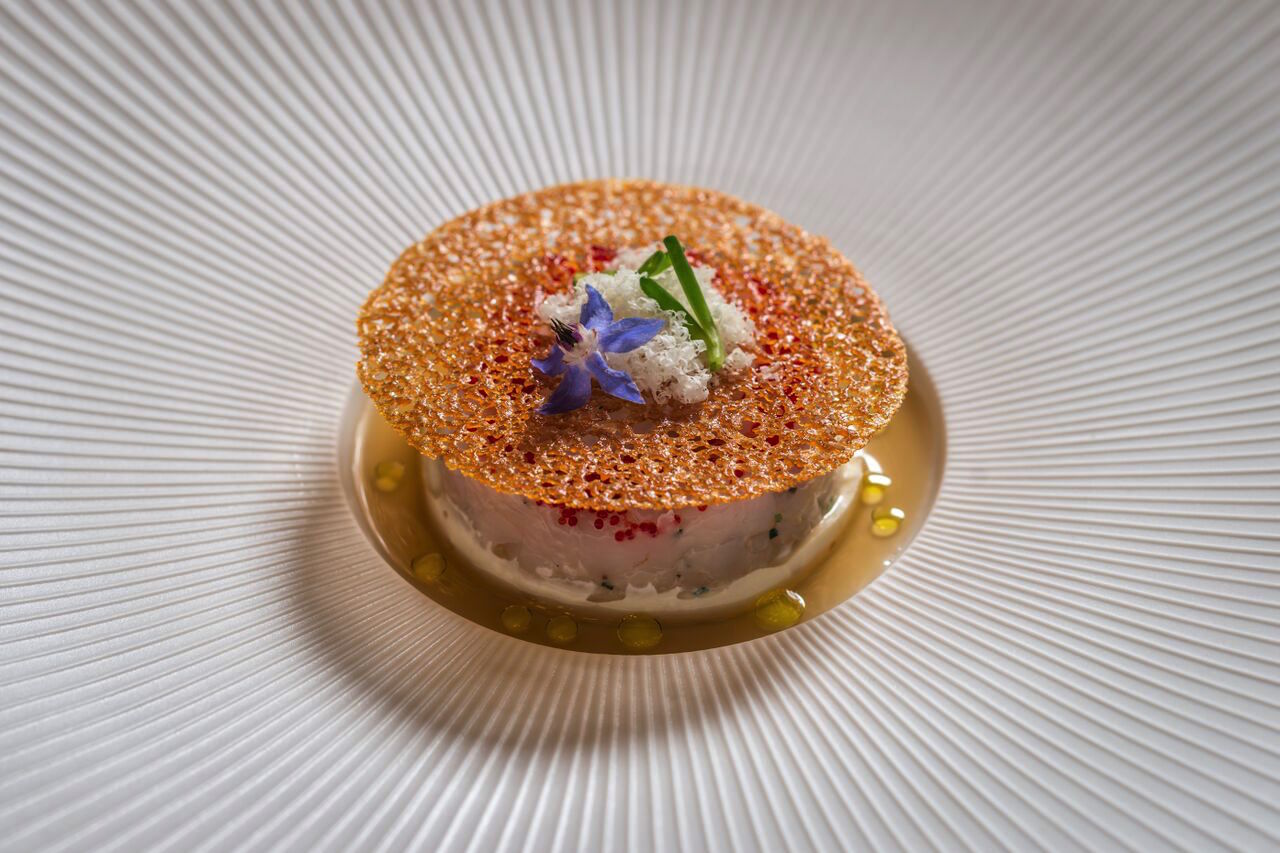 I am going
to try very hard not to pile on superlatives about
the cuisine, but it will be difficult. Kreuther’s
vision of food is based on the principle that, by
using the finest ingredients, very little has to
be done to any of them beyond pairing them up, so
that their flavors remain pure and distinct, while
wholly complementary. He is also well aware of the
importance of an acidic spark--a touch of lemon
juice, a lime leaf, and tangy seasoning--always to
brighten and bring out all the flavors. This is
immediately evident in a starter like 10 days cured beef
tenderloin tartare with a briny razor clam
vinaigrette and the bite of horseradish. A raw
marinated scallop gets a mild kick from a
jalapeño coulis, with soothing black
radish and the tingle of Meyer lemon confit. Kreuther’s use
of foie gras in a terrine has always been a
paragon of the form, here served with woodsy porcini preserve,
duck prosciutto and sweet cantaloupe. A langoustine
tartare (left) comes with flying fish roe,
cauliflower, and a lush macadamia puree.
I am going
to try very hard not to pile on superlatives about
the cuisine, but it will be difficult. Kreuther’s
vision of food is based on the principle that, by
using the finest ingredients, very little has to
be done to any of them beyond pairing them up, so
that their flavors remain pure and distinct, while
wholly complementary. He is also well aware of the
importance of an acidic spark--a touch of lemon
juice, a lime leaf, and tangy seasoning--always to
brighten and bring out all the flavors. This is
immediately evident in a starter like 10 days cured beef
tenderloin tartare with a briny razor clam
vinaigrette and the bite of horseradish. A raw
marinated scallop gets a mild kick from a
jalapeño coulis, with soothing black
radish and the tingle of Meyer lemon confit. Kreuther’s use
of foie gras in a terrine has always been a
paragon of the form, here served with woodsy porcini preserve,
duck prosciutto and sweet cantaloupe. A langoustine
tartare (left) comes with flying fish roe,
cauliflower, and a lush macadamia puree.
Also
showing Alsatian roots is Kreuther’s second course
of sturgeon and sauerkraut tart with a creamy
American caviar mousseline, which arrives under a
glass cloche (below)
that adds just a hint of applewood smoke is a
masterpiece.
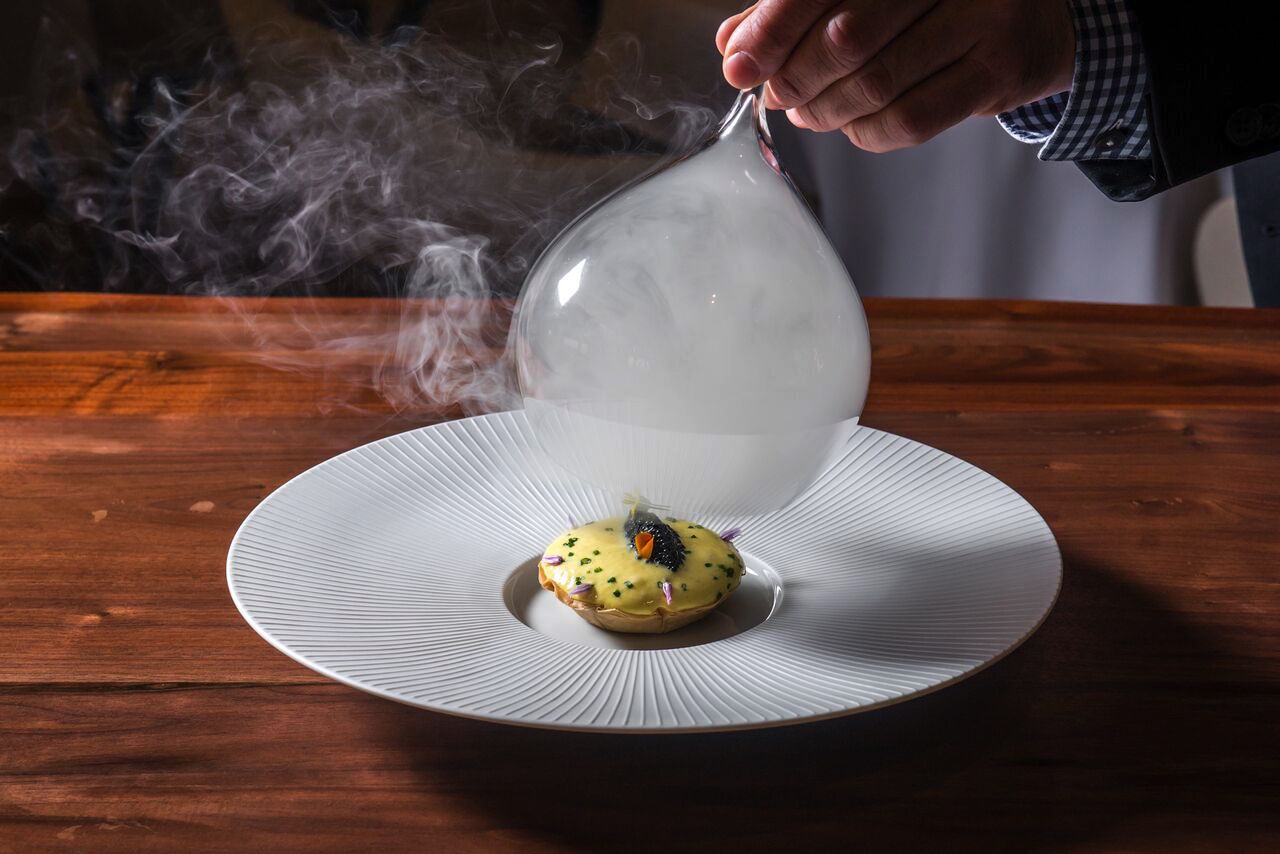 His sweetbread and black
truffle dumplings with a puree of corn and red
currants is a beautiful amalgam of Northern
Italian and American flavors, as is his Munster
cheese and egg raviolo
with spinach, the light crunch of pistachio and
black truffle sauce.
His sweetbread and black
truffle dumplings with a puree of corn and red
currants is a beautiful amalgam of Northern
Italian and American flavors, as is his Munster
cheese and egg raviolo
with spinach, the light crunch of pistachio and
black truffle sauce.
The third course is either
seafood or meat, and I split the difference with
my party of five. Buckwheat breaded Montauk fluke
in a light barley-mushroom
broth with nettle foam wholly respected the
taste and texture of the fish, while a lusty
dish of skirt steak with crispy black trumpet
mushrooms, green leek purée and green
peppercorn
jus proved the versatility of this lowly
cut of beef.
I don’t know what Kreuther does with the
rest of the pig, but his spice- rubbed Mangalitsa
pork collar (a bit chewy that evening) and cheek
with morcilla
blood sausage, apricot, and fennel--pork’s perfect
foil--was drizzled with the kind of careful,
syrupy reduction only a veteran Frenchman like
Kreuther can pass on to his brigade.
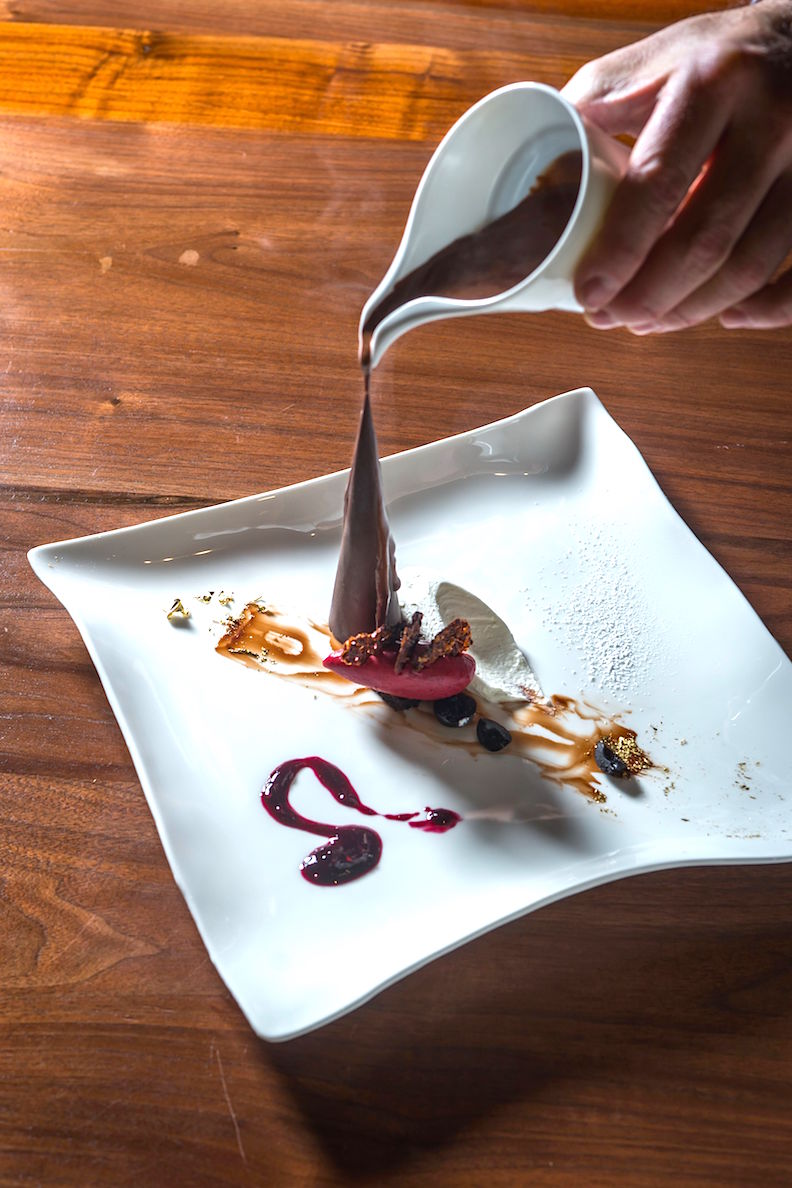 It
was all I could do to wave away a splendid cheese
cart, so that I would have ample room for dessert.
Patîssier Marc Aumont has crafted the kind of
refined desserts you really find only at this
level of cuisine, like his “Fantasy” of chocolate
Kirsch Amarena with Guanaja Chantilly cream, an
olive-oil flavored chocolate sponge cake and
Kirsch sorbet (left);
his aptly named
“Ethereal” pineapple and green apple sphere
with herbs sorbet; a lovely and simple form of
peach Melba as bright as August, with vanilla
mousse sphere and almond cake center, raspberry
sauce and caramelized almonds, raspberry
gelée and peach sorbet; and his “Comfort” dessert
of apricot pistachio passion fruit with roasted
apricot, pistachio mousseline and ten flavor
sorbet. (And here I need note that GK’s pastry
sous-chef, Priscilla Scaff Mariani, who had worked
with him at The Modern, is my daughter-in-law, so
accept that for what it’s worth.)
It
was all I could do to wave away a splendid cheese
cart, so that I would have ample room for dessert.
Patîssier Marc Aumont has crafted the kind of
refined desserts you really find only at this
level of cuisine, like his “Fantasy” of chocolate
Kirsch Amarena with Guanaja Chantilly cream, an
olive-oil flavored chocolate sponge cake and
Kirsch sorbet (left);
his aptly named
“Ethereal” pineapple and green apple sphere
with herbs sorbet; a lovely and simple form of
peach Melba as bright as August, with vanilla
mousse sphere and almond cake center, raspberry
sauce and caramelized almonds, raspberry
gelée and peach sorbet; and his “Comfort” dessert
of apricot pistachio passion fruit with roasted
apricot, pistachio mousseline and ten flavor
sorbet. (And here I need note that GK’s pastry
sous-chef, Priscilla Scaff Mariani, who had worked
with him at The Modern, is my daughter-in-law, so
accept that for what it’s worth.)
The promise of GK was that
Kreuther’s cuisine would be at least as good as
when he was at The Modern. But, by
bringing to bear his Alsatian background and
rigorous training,
he has added an amiable touch of his shy
personality in all he does in dishes unlike what
anyone else is now doing in NYC’s highly
competitive food scene.
And to
enjoy it all in such an enchanting atmosphere--at
such an exemplary price--is a reminder of that
rare quality of the sublime within reach of anyone
receptive enough truly to appreciate all that goes
into it.
Gabriel
Kreuther is open Mon.-Fri. for lunch, and
Mon.-Sat. for dinner.
❖❖❖
NOTES FROM THE
WINE CELLAR
CATCHING
UP WITH GERMAN WINES
By Brian
Freedman
When I was six years old, my father sat me down
at the living room coffee table, opened up three
bottles—a red, a white, and a Champagne—and told
me that, starting that evening, I would begin to
learn about wine with him. During nearly every
dinner thereafter, I’d have a microscopic splash
in my glass, the wine specifically chosen to
pair with whatever magic my mother was whipping
up in the kitchen that evening. Mine was a
childhood awash in Napa Cabernet, Left Bank
Bordeaux, and plenty of Loire Valley Sauvignon
Blanc.
Yet like most Americans in the
1980s, we never--not once--paired German Riesling
with dinner, despite the range of my mother’s
cooking and the infinite opportunities that we
clearly had (in hindsight) to enjoy food alongside
the great whites of Germany. I don’t know
the reasoning for sure, but my hunch is that, even
in a wine-focused home like the one in which I
grew up, German wine was just misunderstood. By
the time I was into my teens, the entirety of my
German-wine knowledge could be summed up in two
concise bullet points: (a) They were sweet, the
sort of thing that I heard was guzzled at the
illicit high school parties I never got invited
to; and (b) their labels were often
indecipherable, printed out in overly ornate
Gothic script like some sort of Grimms’ fairytale
illustration.
It wasn’t until years later
that I tasted my first great one: A J.J.
Christoffel Erben Riesling Spätlese Urziger
Wurzgarten. It changed my wine life forever.
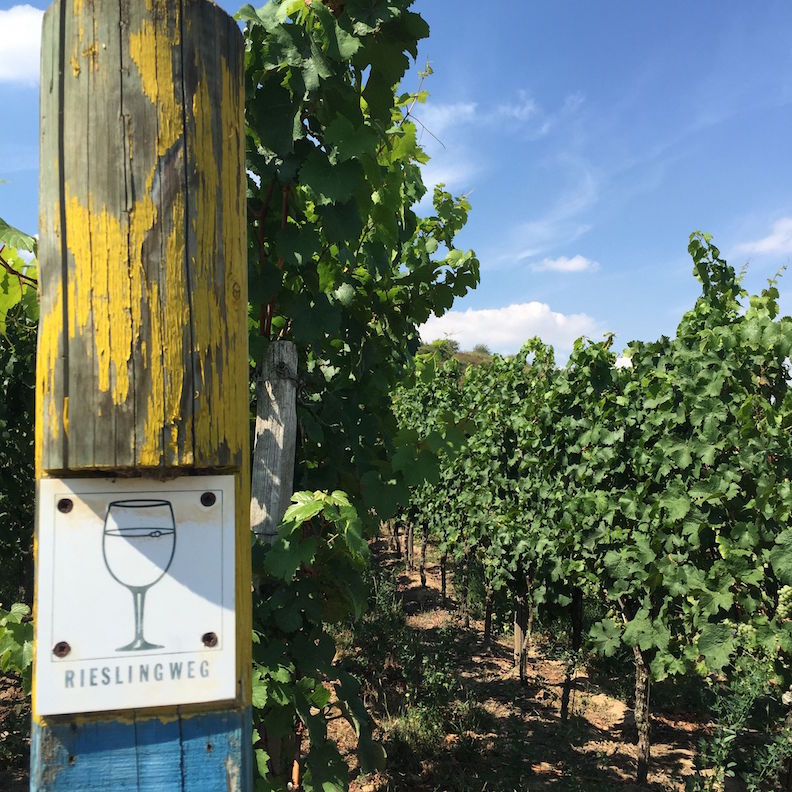 Since then I have been
on a quest to wrap my head around the astounding
diversity of German bottlings, a national wine
culture as vibrant, fascinating, and wide-ranging
as any in the world right now. Frustratingly,
among too many consumers at least, German wines
are still pigeonholed in ways that they absolutely
should not be. Sommeliers and beverage directors
are putting their weight behind them, and having
some significant success selling them tableside at
their restaurants, but among too large a swath of
the wine-drinking public, the whole category of
German wine remains a mystery. Yet I have a strong
suspicion that all of that is about to change.
Since then I have been
on a quest to wrap my head around the astounding
diversity of German bottlings, a national wine
culture as vibrant, fascinating, and wide-ranging
as any in the world right now. Frustratingly,
among too many consumers at least, German wines
are still pigeonholed in ways that they absolutely
should not be. Sommeliers and beverage directors
are putting their weight behind them, and having
some significant success selling them tableside at
their restaurants, but among too large a swath of
the wine-drinking public, the whole category of
German wine remains a mystery. Yet I have a strong
suspicion that all of that is about to change.
Last
month, I spent nearly a week in Germany at the
invitation of the German Wine Board, with the
explicit purpose of exploring (and therefore
increasing my understanding of) the world-class
wine regions of Pfalz, Rheingau, and Rheinhessen.
I came away from the experience not just with an
increased respect for the wines, but, more
importantly, a deep sense of excitement for their
future. The German wine industry is infinitely
more exciting than it is given credit for, and
beyond its marquis grape variety Riesling, the
breadth of expressions is nothing less than
stunning.
Much of this has to do with
what might be called the inherent
terroir-specificity of Riesling, a variety that
has an uncanny ability to allow the land in which
it grows to shimmer through with crystalline
clarity. The place-name on the label of great
German Riesling is more than an indication of
origins; it’s also often an indication of
character. (This is true of so many other grape
varieties there, too, not just Riesling.)
This was made beautifully visible during a tasting
of wines grown on the red slate slopes of
Nierstein’s Roten Hang (right). 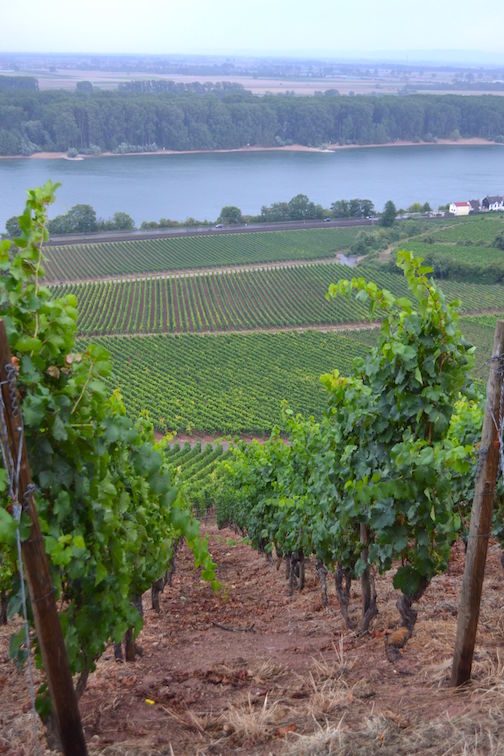 Over the
course of the evening, we spoke with, and enjoyed
the wines of, three producers whose vision, energy
and passion embody all of the excitement of the
new German winemaking culture. Highlights of the
evening--in addition to the amazing beef and pork
from Metzgerei David in Worms cooked up by the
remarkable Kai Schätzel--included the 2012 and
2013 Pettenthal Rieslings from both Schätzel and
Weingut St. Anthony, the 2014 Pettenthal Sauvignon
Blanc from Weingut Sebastian Strub, and the 2013
and 2014 Nierstein Silvaners from Schätzel, which
benefited from a week’s maceration on the skins. I
also loved the 2014 Hipping Riesling from Weingut
Lisa Bunn.
Over the
course of the evening, we spoke with, and enjoyed
the wines of, three producers whose vision, energy
and passion embody all of the excitement of the
new German winemaking culture. Highlights of the
evening--in addition to the amazing beef and pork
from Metzgerei David in Worms cooked up by the
remarkable Kai Schätzel--included the 2012 and
2013 Pettenthal Rieslings from both Schätzel and
Weingut St. Anthony, the 2014 Pettenthal Sauvignon
Blanc from Weingut Sebastian Strub, and the 2013
and 2014 Nierstein Silvaners from Schätzel, which
benefited from a week’s maceration on the skins. I
also loved the 2014 Hipping Riesling from Weingut
Lisa Bunn.
Silvaner, I suspect, is poised
to see its stock climb to the levels it so richly
deserves. Long an afterthought on the American
market, the Silvaners I tasted were stunning in
their clarity and beyond exciting in the range of
styles in which they are being crafted, from the
crisp and refreshing to the unexpectedly
age-worthy.
Weissburgunder is also on the
rise. More familiarly known as Pinot Blanc, it’s a
variety that I kept going back to while in
Germany. The spicy, bright 2014 Weissburgunder
Trocken from Weingut Heinrich Spindler was a
food-pairing dream, and the Weingut Odinstal
Weissburgunder “Basalt” 2014 was among the top
wines I tasted all week, its spice and honeyed
notes framing peach, yellow apple and a smoky
minerality with grace, balance and phenomenal
depth. (Their 2014 Silvaner Nature, which is
partially crafted in buried amphorae, was deeply
memorable, too.)
That
balance is one of the great calling cards of
German wine right now, a trait that makes them
excellent to sip on their own yet tremendously
versatile at the table. This is true for the still
wines as much as the sparkling ones, like
Odinstal’s Brut Nature (only bottled in magnum)
and Weingut Joachim Flick’s 2013 Wickerer Nonnberg
Riesling Sekt Brut. And I was bowled over by the
quality and range of bottlings on offer at Strauch
Sektmanufaktur, which was more than worthy of
being named Gault-Millau’s German wine discovery
of the year last year, a distinction that has
required them to double production and, for the
first time, not to sell any of their estate-grown
grapes, but instead to use them all in their own
bottlings. If you see these sparklers in the
market or on a wine list, buy them immediately.
Sauvignon Blanc is also finding
a voice and an audience for itself--producers are
experimenting with harvest times and winemaking 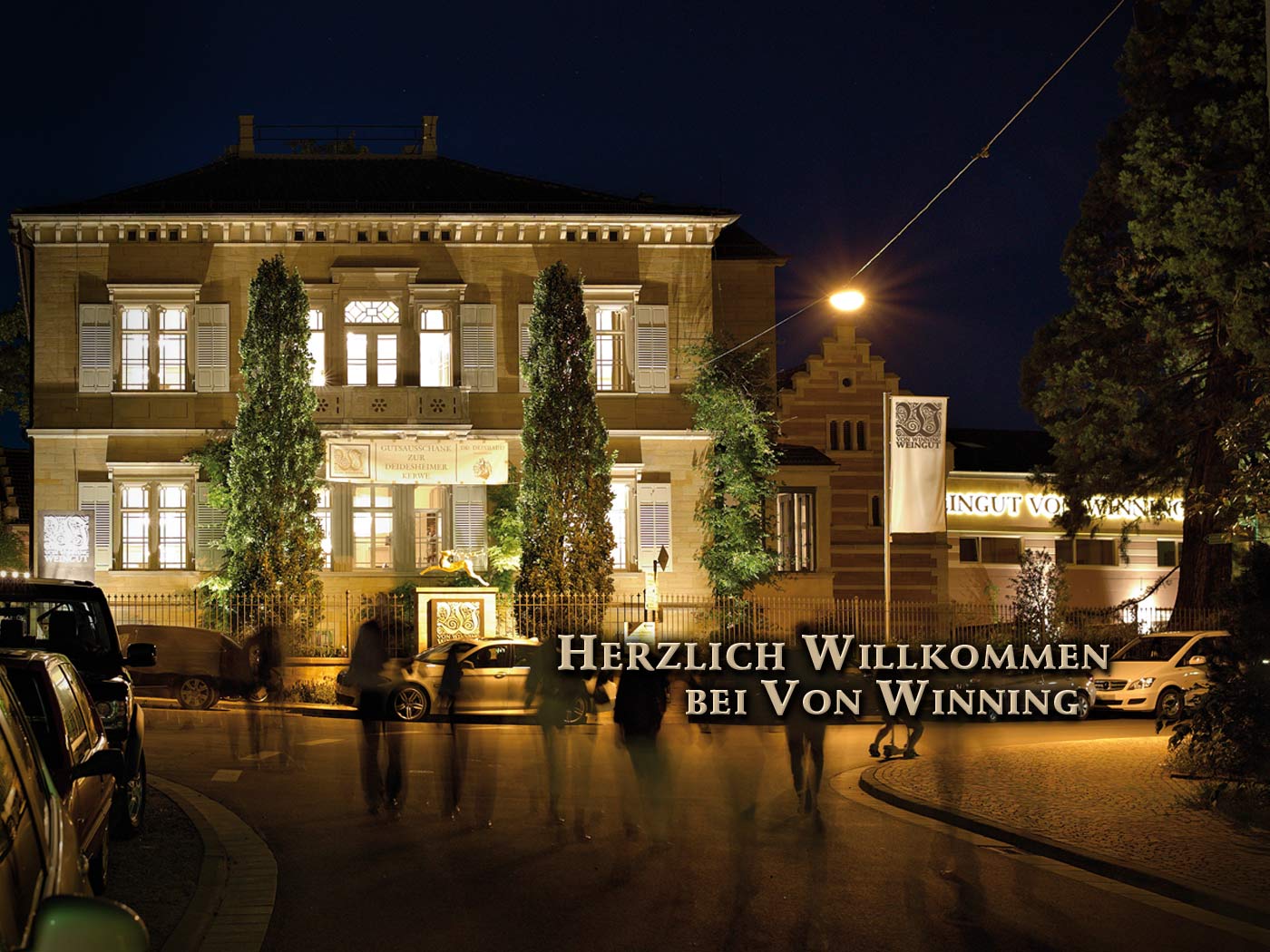 techniques to coax from
the grape variety a unique sense of
expressiveness. Weingut am Nil is doing a nice job
with a more classical expression of it, whereas
Weingut Mussler is working with a more tropical
style in their 2013 Sauvignon Blanc Fransheim; its
honeyed and floral notes are immediately
appealing. Weingut von Winning is also a source
for excellent Sauvignon Blanc that I’d recommend
seeking out.
techniques to coax from
the grape variety a unique sense of
expressiveness. Weingut am Nil is doing a nice job
with a more classical expression of it, whereas
Weingut Mussler is working with a more tropical
style in their 2013 Sauvignon Blanc Fransheim; its
honeyed and floral notes are immediately
appealing. Weingut von Winning is also a source
for excellent Sauvignon Blanc that I’d recommend
seeking out.
Weingut Schneider won me over
with two tasty ones--the 2014 Kaitui and the 2014
Kaitui Fumé, the latter based on two clones from
Northern Italy and boasting more smoky aromatics
than the former--but I was just as impressed with
their reds. The 2012 Syrah “Holy Moly” was a
dead-ringer for Northern Rhône on the nose, and
the 2009 bottling of the same wine was more
California in character, its 15% alcohol balanced
and pulsing through a wine of serious exuberance.
Their Tailor Reserve, a blend of Merlot and
Cabernet Franc, also showed brilliantly in both
its 2007 and 2004 vintages. (Their 2003 Riesling
Saumagen, with its lanolin, nectarine, mint, and
petrol notes, was both exciting and wholly unique
at the same time.)
There
is, indeed, a new generation that seems to be
pushing both German wine itself, and the
perception of it around the world, in new
directions by both respecting the past and blazing
their own path to the future. Jochen
Dreissigacker, for example, is, at his eponymous
winery, crafting wines of notable purity and
finesse. His impossibly complex, deeply
pleasurable 2010 Riesling Geyserberg, for
instance, embodies so much of what makes the new
German wine so exciting. I got the same feeling
throughout my time in Germany the other week. This
sort of exuberance and energy is contagious, and I
suspect that more and more consumers on this side
of the ocean will continue to discover and
appreciate it. I certainly have.

TO EACH
HIS OWN
“During
the summer of 2012, I had perhaps the most glorious
run of swine dining in my pig-laden life. Over a
24-hour period in the Winston-Salem metropolitan
area, I hit up Snooks, Tarheel Q and the legendary
Lexington Barbecue.”—Alex Hochman, “Rusty’s
Barbecue,” SF
Examiner (7/26/15)
WHICH IS KINDA LIKE
NAMING THE MOST
INFLUENTIAL  BASEBALL PLAYERS WITHOUT
BASEBALL PLAYERS WITHOUT
MENTIONING WILLY MAYS
Any of John Mariani's books below may be ordered from amazon.com.
 I'm proud and happy to announce that my
new book, The Hound
in Heaven (21st Century Lion Books), has just
been published through Amazon and Kindle.
I'm proud and happy to announce that my
new book, The Hound
in Heaven (21st Century Lion Books), has just
been published through Amazon and Kindle. It is a novella, and for anyone who loves dogs, Christmas, romance, inspiration, even the supernatural, I hope you'll find this to be a treasured favorite. The story concerns how, after a New England teacher, his wife and their two daughters adopt a stray puppy found in their barn in northern Maine, their lives seem full of promise. But when tragedy strikes, their wonderful dog Lazarus and the spirit of Christmas are the only things that may bring back his master back from the edge of despair.
WATCH THE VIDEO!
“What a huge surprise turn this story took! I was completely stunned! I truly enjoyed this book and its message.” – Actress Ali MacGraw
“He had me at Page One. The amount of heart, human insight, soul searching, and deft literary strength that John Mariani pours into this airtight novella is vertigo-inducing. Perhaps ‘wow’ would be the best comment.” – James Dalessandro, author of Bohemian Heart and 1906.
“John Mariani’s Hound in Heaven starts with a well-painted portrayal of an American family, along with the requisite dog. A surprise event flips the action of the novel and captures us for a voyage leading to a hopeful and heart-warming message. A page turning, one sitting read, it’s the perfect antidote for the winter and promotion of holiday celebration.” – Ann Pearlman, author of The Christmas Cookie Club and A Gift for my Sister.
“John Mariani’s concise, achingly beautiful novella pulls a literary rabbit out of a hat – a mash-up of the cosmic and the intimate, the tragic and the heart-warming – a Christmas tale for all ages, and all faiths. Read it to your children, read it to yourself… but read it. Early and often. Highly recommended.” – Jay Bonansinga, New York Times bestselling author of Pinkerton’s War, The Sinking of The Eastland, and The Walking Dead: The Road To Woodbury.
“Amazing things happen when you open your heart to an animal. The Hound in Heaven delivers a powerful story of healing that is forged in the spiritual relationship between a man and his best friend. The book brings a message of hope that can enrich our images of family, love, and loss.” – Dr. Barbara Royal, author of The Royal Treatment.
 |
The Encyclopedia of American Food and Drink by John F. Mariani (Bloomsbury USA, $35) Modesty forbids me to praise my own new book, but let me proudly say that it is an extensive revision of the 4th edition that appeared more than a decade ago, before locavores, molecular cuisine, modernist cuisine, the Food Network and so much more, now included. Word origins have been completely updated, as have per capita consumption and production stats. Most important, for the first time since publication in the 1980s, the book includes more than 100 biographies of Americans who have changed the way we cook, eat and drink -- from Fannie Farmer and Julia Child to Robert Mondavi and Thomas Keller. "This book is amazing! It has entries for everything from `abalone' to `zwieback,' plus more than 500 recipes for classic American dishes and drinks."--Devra First, The Boston Globe. "Much needed in any kitchen library."--Bon Appetit. |
"Eating Italian will never be the same after reading John Mariani's entertaining and savory gastronomical history of the cuisine of Italy and how it won over appetites worldwide. . . . This book is such a tasteful narrative that it will literally make you hungry for Italian food and arouse your appetite for gastronomical history."--Don Oldenburg, USA Today. "Italian
restaurants--some good, some glitzy--far
outnumber their French rivals. Many of
these establishments are zestfully described
in How Italian Food Conquered the World, an
entertaining and fact-filled chronicle by
food-and-wine correspondent John F.
Mariani."--Aram Bakshian Jr., Wall Street
Journal.
"Equal parts
history, sociology, gastronomy, and just
plain fun, How Italian Food Conquered the
World tells the captivating and delicious
story of the (let's face it) everybody's
favorite cuisine with clarity, verve and
more than one surprise."--Colman Andrews,
editorial director of The Daily
Meal.com. "A fantastic and fascinating
read, covering everything from the influence
of Venice's spice trade to the impact of
Italian immigrants in America and the
evolution of alta cucina. This book will
serve as a terrific resource to anyone
interested in the real story of Italian
food."--Mary Ann Esposito, host of PBS-TV's
Ciao
Italia. "John Mariani has written the
definitive history of how Italians won their
way into our hearts, minds, and
stomachs. It's a story of pleasure over
pomp and taste over technique."--Danny Meyer,
owner of NYC restaurants Union Square
Cafe, The Modern, and Maialino.
|
 |
 |
 |
 |
 |
 |
 |
 |
 Everett Potter's Travel Report:
Everett Potter's Travel Report: 
 Eating Las
Vegas is the new on-line site for
Virtual Gourmet contributor John A. Curtas.,
who since 1995 has been commenting on the
Las Vegas food scene and reviewing
restaurants for Nevada Public Radio.
He is also the restaurant critic for KLAS
TV, Channel 8 in Las Vegas, and his past
reviews can be accessed at KNPR.org.
Click on the logo below to go directly to
his site.
Eating Las
Vegas is the new on-line site for
Virtual Gourmet contributor John A. Curtas.,
who since 1995 has been commenting on the
Las Vegas food scene and reviewing
restaurants for Nevada Public Radio.
He is also the restaurant critic for KLAS
TV, Channel 8 in Las Vegas, and his past
reviews can be accessed at KNPR.org.
Click on the logo below to go directly to
his site.

Tennis Resorts Online: A Critical Guide to the World's Best Tennis Resorts and Tennis Camps, published by ROGER COX, who has spent more than two decades writing about tennis travel, including a 17-year stretch for Tennis magazine. He has also written for Arthur Frommer's Budget Travel, New York Magazine, Travel & Leisure, Esquire, Money, USTA Magazine, Men's Journal, and The Robb Report. He has authored two books-The World's Best Tennis Vacations (Stephen Greene Press/Viking Penguin, 1990) and The Best Places to Stay in the Rockies (Houghton Mifflin, 1992 & 1994), and the Melbourne (Australia) chapter to the Wall Street Journal Business Guide to Cities of the Pacific Rim (Fodor's Travel Guides, 1991).


MARIANI'S VIRTUAL GOURMET
NEWSLETTER is published weekly. Editor/Publisher: John
Mariani.
Editor: Walter Bagley. Contributing Writers: Christopher Mariani,
Robert Mariani, Misha
Mariani,
John A. Curtas, Edward Brivio, Mort Hochstein,
Andrew Chalk, Dotty Griffith and Brian Freedman. Contributing
Photographers: Galina Dargery, Bobby
Pirillo. Technical Advisor: Gerry McLoughlin.
To un-subscribe from this newsletter,click here.
© copyright John Mariani 2015

